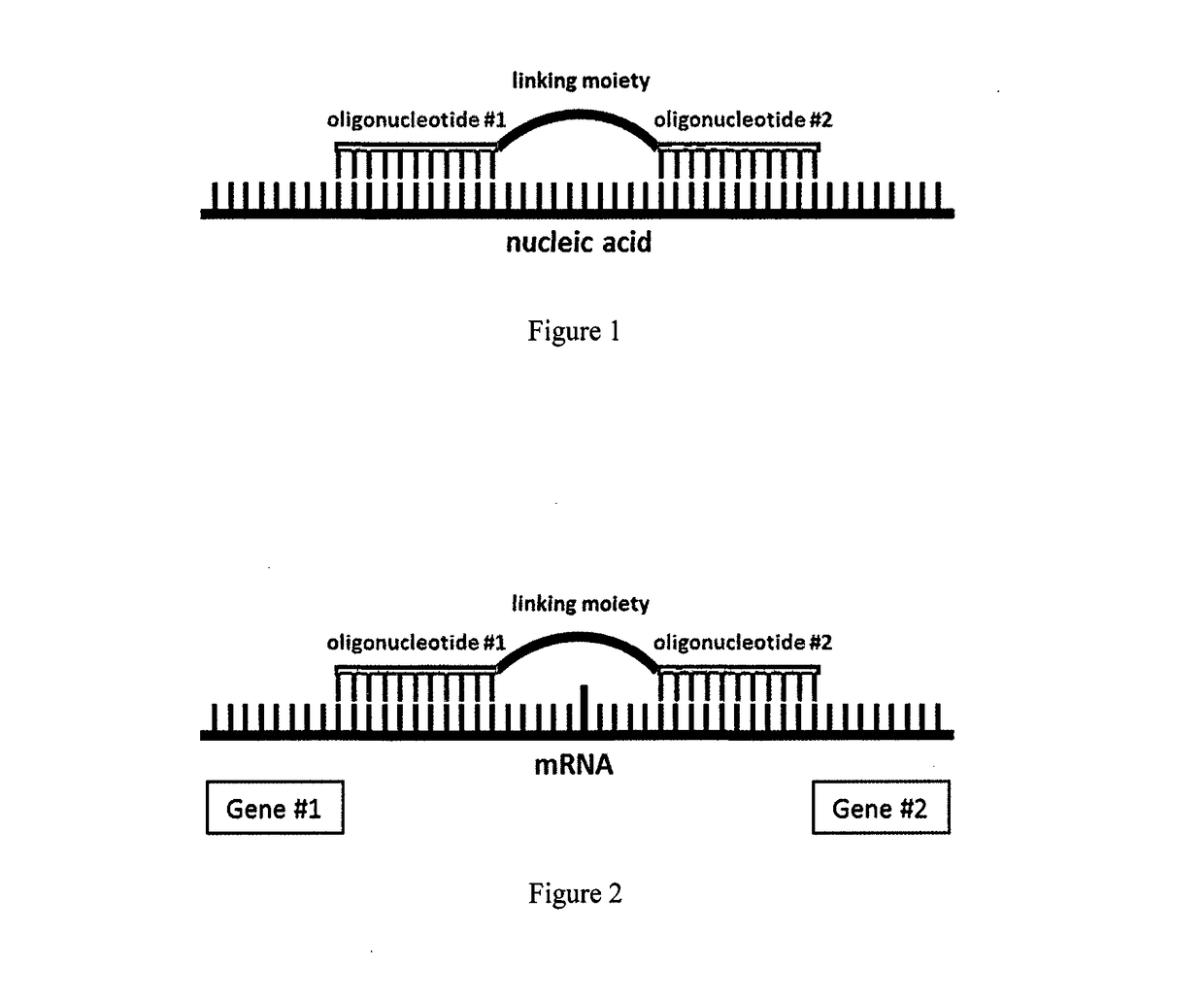A method for altering the functional state of mRNA allowing its selective and specific recognition
- Summary
- Abstract
- Description
- Claims
- Application Information
AI Technical Summary
Benefits of technology
Problems solved by technology
Method used
Image
Examples
example 1
[0069]Selective and specific recognition of the BCR-ABL fusion mRNA in chronic myelogenous leukemia or Ph+ acute lymphoblastic leukemia, or other neoplasia where BCR-ABL fusion mRNA is present, using the present invention.
[0070]The proposed construct selectively and specifically recognizes the BCR-ABL mRNA in a way when the first sequence-specific oligonucleotide targets the sequence of BCR and the second oligonucleotide targets the sequence of ABL, whilst both of the oligonucleotides are mutually interconnected through a size-specific polymeric linking moiety. It is also possible to apply more than two sequence-specific oligonucleotides, when each of them targets either the BCR or ABL, wherein each of the fusion partners is targeted by at least one oligonucleotide. The sequence-specific oligonucleotides are mutually interconnected through a corresponding number of polymeric linking moieties. A stable, thermodynamically and energetically preferable complementary interaction between ...
example 2
[0075]Selective and specific recognition of the AML1-ETO fusion mRNA in acute myeloid leukemia M2 or other neoplasia where AML1-ETO fusion mRNA is present, using the present invention.
5′atcaaaa tcacagtgga tgggccccga gaacctcgaa atcgtactga gaagcactcc acaatgccag actcacctgtggatgtgaag acgcaatcta ggctgactcc tccaacaatgccacctcccc caactactca aggagctcca agaaccagttcatttacacc gacaacgtta actaatggca cgagccattctcctacagcc ttgaatggcg ccccctcacc acccaatggc
[0076]Partial primary sequence of fusion AML1-ETO mRNA (GenBank: S78158.1); AML1—black, ETO—grey; target sequences are underlined.
linking moiety (17 nt gap)3′ TAGTGTCACCTACCCG ---------------- GCATGACTCTTCGTGAGG 5′
[0077]Example of the construct designed for selective and specific recognition of AML1-ETO mRNA. The complementary oligonucleotide to AML1 (16 nt) and ETO (18nt) are shown in black and grey, respectively.
example 3
[0078]Selective and specific recognition of the CBFB-MYH11 fusion mRNA in acute myeloid leukemia M4 or other neoplasia where CBFB-MYH11 fusion mRNA is present, using the present invention.
5′tttgaag atagagacag gtctcatcgg gaggaaatggagaatgaagt tgagagcgtc acagggatgc ttaacgaggccgaggggaag gccattaagc tggccaagga cgtggcgtccctcagttccc agctccagga cacccaggag tt
[0079]Partial primary sequence of fusion CBFB-MYH11 mRNA (GenBank: AF249897.1); CBFB—black, MYH11—grey; target sequences are underlined.
linking moiety (12 nt gap)3′ TATCTCTGTCCAGAGTAGCC ---------------- TTACTTCAACTCTCG 5′
[0080]Example of the construct designed for selective and specific recognition of CBFB-MYH11 mRNA. The complementary oligonucleotide to CBFB (20 nt) and MYH11 (15nt) are shown in black and grey, respectively.
PUM
| Property | Measurement | Unit |
|---|---|---|
| Force | aaaaa | aaaaa |
| Length | aaaaa | aaaaa |
| Size | aaaaa | aaaaa |
Abstract
Description
Claims
Application Information
 Login to View More
Login to View More - R&D
- Intellectual Property
- Life Sciences
- Materials
- Tech Scout
- Unparalleled Data Quality
- Higher Quality Content
- 60% Fewer Hallucinations
Browse by: Latest US Patents, China's latest patents, Technical Efficacy Thesaurus, Application Domain, Technology Topic, Popular Technical Reports.
© 2025 PatSnap. All rights reserved.Legal|Privacy policy|Modern Slavery Act Transparency Statement|Sitemap|About US| Contact US: help@patsnap.com



